2017 年广东财经大学英语水平考试考研真题
考试年度:2017 年
考试科目代码及名称:613-英语水平考试
适用专业:050201 英语语言文学
[友情提醒:请在考点提供的专用答题纸上答题,答在本卷或草稿纸上无效!]
I. Cloze 完形填空(30 题,每题 1 分,共 30 分)
Direction: There are 3 passages below. Read each of them and choose the proper word
from the word list to fill in each of the blanks in the passages. Each word can be
used only once.
Passage 1
Two of the most frustrating things about driving a car are getting lost and
getting stuck in traffic. While the computer revolution is (1)_____to cure these
problems, it will have a positive impact. Sensors in your car tuned to radio signals
from (2)____satellites can locate your car (3)_____at any moment and warn of traffic
jams. We already have twenty-four Navstar satellites orbiting the earth, making up
what is called the Global Positioning System. They make it possible to determine
your
(4)_______on the earth to within about a hundred feet. At any (5)______time,
there are several GPS satellites orbiting overhead at a distance of about 11,000
miles. Each satellite contains four “atomic clocks,” which (6)_____ at a precise
frequency, according to the laws of the quantum theory.
As a satellite passes overhead, it sends out a radio (7)___that can be detected
by a receiver in a car’s computer.
The car’s computer can then (8)___how far the
satellite is by (9)____how long it took for the signal to arrive. Since the speed
of light is well known, any delay in receiving the satellite’s signal can be
(10)_____into a distance.
A. given
E. signal
I. unlikely
B. precisely
F. measuring
J. orbiting
C. poised
G. frequency
K. location
D. vibrate
H. grossly
L. expansion
Passage 2
�
More
than 30
million cars and trucks nationwide are (1) with dangerously
(2)____air bags, congressional officials say, a number that raises questions about
whether the US (3)____industry can handle what could become the largest recall in
history.
Federal safety (4)____have recalled only 7.8
million vehicles
over the defect
in a few states, a limited action that (5)____said Thursday was vastly insufficient
to (6)____what they deemed “a public safety threat”.
Two senators demanded a much (7)____recall that would cover every affected
vehicle nationwide. (8)_____a recall of that magnitude ---- including best-selling
models from Honda, Toyota,
GM,
Chrysler
and
six
other companies (9)____
2002 to 2007 ---- could prove far (10)_____than the industry has ever managed.
A. faulty
B.struggling
C. broader
D. auto
E. logistical
F. but
G.authorities
H. defective
I. lawmakers
J. address
K. overwhelmed
L. greater
M. equipped
N. replacement
O. spanning
Passage 3
Britain is not just one country and one people; even if some of its inhabitants
think so. Britain is, in fact, a nation which can be divided into several (1) __
parts, each part being an individual country with its own language, character and
cultural (2) __. Thus Scotland, Northern Ireland and Wales do not claim to (3) __
to "England" because their inhabitants are not (4) __ "English". They are Scottish,
Irish or Welsh and many of them prefer to speak their own native tongue, which in
turn is (5) __ to the others.
These cultural minorities(少数民族) have been Britain’s original inhabitants.
In varying degrees they have managed to (6) __ their national characteristics, and
their particular customs and way of life. This is probably even more true of the
(7) __ areas where traditional life has not been so affected by the (8)__ of
industrialism as the border areas have been. The Celtic races are said to be more
�
emotional by nature than the English. An Irish temper is legendary. The Scots could
rather (9) __ about their reputation for excessive thrift and prefer to be remembered
for their folk songs and dances, while the Welsh are famous for their singing. The
Celtic (10)__ as a whole produces humorous writers and artists, such as the Irish
Bernard Shaw, the Scottish Robert Burns, and the Welsh Dylan Thomas, to mention but
a few.
A. incomprehensible
B. temper
C. remote
D. separate E. understandable
F. forget
G. generally
H. temperament
I. preserve
J. strictly
K. traditional
L. reserve
M. growth
N. apply
O. belong
II. Proofreading and error correction 改错题 (15 题,每题 2 分,共 30 分)
Directions: The following passage contains 15 errors. Each indicated line contains
a maximum of ONE error. In each case, only ONE word is involved. Correct the errors
and write the answers on your answer sheet.
What is corporate culture? At its most basic, it’s described like
(1) ____
the personality of an organization, or simply as “how things are
done around here.” It guides what employees think, act, and feel.
(2)_____
Corporate culture is a wide term used to define the unique
(3)
_____
personality or character of a particular company or organization,
and include such elements as core values and beliefs, corporate
(4) _____
ethics, and rules of behavior. Corporate culture can express
(5) _____
in the company’s mission statement and other communications,
in the architectural style or interior decoration, by what people wear
to work, by how people address to each other, and in the titles given
(6) _____
various employees. How do you uncover the corporate culture of
(7) _____
a potential employer? The truth is that you will never really know
the corporate culture after you have worked at the company for a
(8)______
number of months, but you can get close to them through research
(9)______
�
and observation. Understanding culture is a two-steps process,
(10) _____
starting with the research before the interview and ending
(11)______
with observation at the interview. The bottom line is that
you are going to spend a lot of time on the work environment-
(12)______
and to be happy, success, and productive, you will want to
(13)______
be in a place where you fit for the culture, a place where you
(14)______
can have voice, be respected, and have opportunities for
(15)______
growth.
III. Gap-filling 选词填空题(15 题,每题 2 分,共 30 分)
Directions: Fill in the following blanks with the correct words given according to
the meanings of the sentences.
1. Environmentalists are doing everything within their power to ________ the impact
of the oil spill.
A. minimize
C. reject
B. belittle
D. reclaim
2. Topics for conversation should be ________ to the experiences and interests of
the students.
A. satisfied
C. concerned
B. relevant
D. concentrated
3. They said the operation had been successful and they expected his wife to
________.
A. bring about
C. carry on
B. pull through
D. put up
4. We could tell that she was still ________ something and it was our job to find
out what.
A. canceling
C. concealing
B. sheltering
D. settling
5. You are legally ________ to take faulty goods back to the store where you bought
�
them.
A. assigned
C. acclaimed
B. entitled
D. remained
6. His knowledge of English is ________ for the job, although he is not fluent in
the language.
A. justified
C. adequate
B. reliable
D. assured
7. The scientists have been ________ the necessary funds for their research program.
A. desired
C. declined
B. neglected
D. denied
8. There is always a ________ that the legal system is designed to suit lawyers
rather than to protect the public.
A. confidence
C. deception
B. faith
D. suspicion
9. A spokesman of Ministry of Agriculture said that a series of policies would be
implemented to ________ the development of agriculture.
A. demote
C. decrease
B. promote
D. increase
10. A dark suit is ________ to a light one for evening wear.
A. favorable
C. proper
B. suitable
D. preferable
11. The foreign company has been ________ running this factory for decades.
A. enormously
C. infinitely
B. effectively
D. extremely
12. I’m not sick; ________, I’m in the peak of health.
A. to be honest
C. to my delight
B. on the contrary
D. on all sides
13.By a ________ of good luck, Gene, who had been buried in the rubble for more than
26 hours, came out alive.
A. stroke
B. hit
�
C. strike
D. blow
14. Advertising is an intensely ________ business.
A. competitive
C. adventurous
B. aggressive
D. lucrative
15. She was _______ upset to find that she failed in the final examination.
A. somehow
C. somewhat
B. someway
D. somewhere
IV. Reading Comprehension 阅读理解(30 题,每题 2 分,共 60 分)
Directions: In this section, there six reading passages followed by a total of thirty
multiple-choice questions. Read the passages carefully and then choose the correct
answer.
Passage 1
The Birth of Photography
【1】Perceptions of the visible world were greatly altered by the invention of
photography in the middle of the nineteenth century. In particular, and quite
logically, the art of painting was forever changed, though not always in the ways
one might have expected. The realistic and naturalistic painters of the mid- and
late-nineteenth century were all intently aware of photography—as a thing to use,
to learn from, and react to.
【2】Unlike most major inventions, photography had been long and impatiently awaited.
The images produced by the camera obscura, a boxlike device that used a pinhole or
lens to throw an image onto a ground-glass screen or a piece of white paper, were
already familiar—the device had been much employed by topographical artists like
the Italian painter Canaletto in his detailed views of the city of Venice. What was
lacking was a way of giving such images permanent form. This was finally achieved
by Louis Daguerre (1787-1851), who perfected a way of fixing them on a silvered copper
plate. His discovery, the "daguerreotype," was announced in 1839.
【3】A second and very different process was patented by the British inventor William
Henry
Talbot
(1800-1877)
in
1841.
Talbot's
"calotype"
was
the
first
�
negative-to-positive process and the direct ancestor of the modern photograph. The
calotype was revolutionary in its use of chemically treated paper in which areas
hit by light became dark in tone, producing a negative image. This "negative," as
Talbot called it, could then be used to print multiple positive images on another
piece of treated paper.
【4】The two processes produced very different results. The daguerreotype was a
unique image that reproduced what was in front of the camera lens in minute,
unselective detail and could not be duplicated. The calotype could be made in series,
and was thus the equivalent of an etching or an engraving. Its general effect was
soft edged and tonal.
【5】One of the things that most impressed the original audience for photography
was the idea of authenticity. Nature now seemed able to speak for itself, with a
minimum of interference. The title Talbot chose for his book, The Pencil of Nature
(the first part of which was published in 1844), reflected this feeling. Artists
were fascinated by photography because it offered a way of examining the world in
much greater detail. They were also afraid of it, because it seemed likely to make
their own efforts unnecessary.
【 6 】 Photography did indeed make certain kinds of painting obsolete — the
daguerreotype virtually did away with the portrait miniature. It also made the whole
business of making and owning images democratic. Portraiture, once a luxury for the
privileged few, was suddenly well within the reach of many more people.
【7】In the long term, photography's impact on the visual arts was far from simple.
Because the medium was so prolific, in the sense that it was possible to produce
a multitude of images very cheaply, it was soon treated as the poor relation of fine
art, rather than its destined successor. Even those artists who were most dependent
on photography became reluctant to admit that they made use of it, in case this
compromised their professional standing.
【8】The rapid technical development of photography—the introduction of lighter
and simpler equipment, and of new emulsions that coated photographic plates, film,
and paper and enabled images to be made at much faster speeds—had some unanticipated
�
consequences. Scientific experiments made by photographers such as Eadweard
Muybridge (1830-1904) and Etienne-Jules Marey (1830-1904) demonstrated that the
movements of both humans and animals differed widely from the way they had been
traditionally represented in art. Artists, often reluctantly, were forced to accept
the evidence provided by the camera. The new candid photography—unposed pictures
that were made when the subjects were unaware that their pictures were being taken
—confirmed these scientific results, and at the same time, thanks to the radical
cropping (trimming) of images that the camera often imposed, suggested new
compositional formats. The accidental effects obtained by candid photographers were
soon being copied by artists such as the French painter Degas.
1.What can be inferred from paragraphs 1 and 2 about the effect of photography on
nineteenth-century painting?
A. Photography did not significantly change the way people looked at reality.
B. Most painters used the images of the camera obscura in preference to those of
the daguerreotype.
C. Painters who were concerned with realistic or naturalistic representation were
particularly influenced by photography.
D. Artists used the long-awaited invention of photography in just the ways they had
expected to.
2. According to paragraphs 2 and 3 which of the following did the daguerreotype
and the calotype have in common?
A. They were equally useful for artists.
B. They could be reproduced.
C. They produced a permanent image
D. They were produced on treated paper.
3. The word "authenticity" in paragraph 5 is closest in meaning to
A. improvement.
B. practicality.
C. genuineness.
�
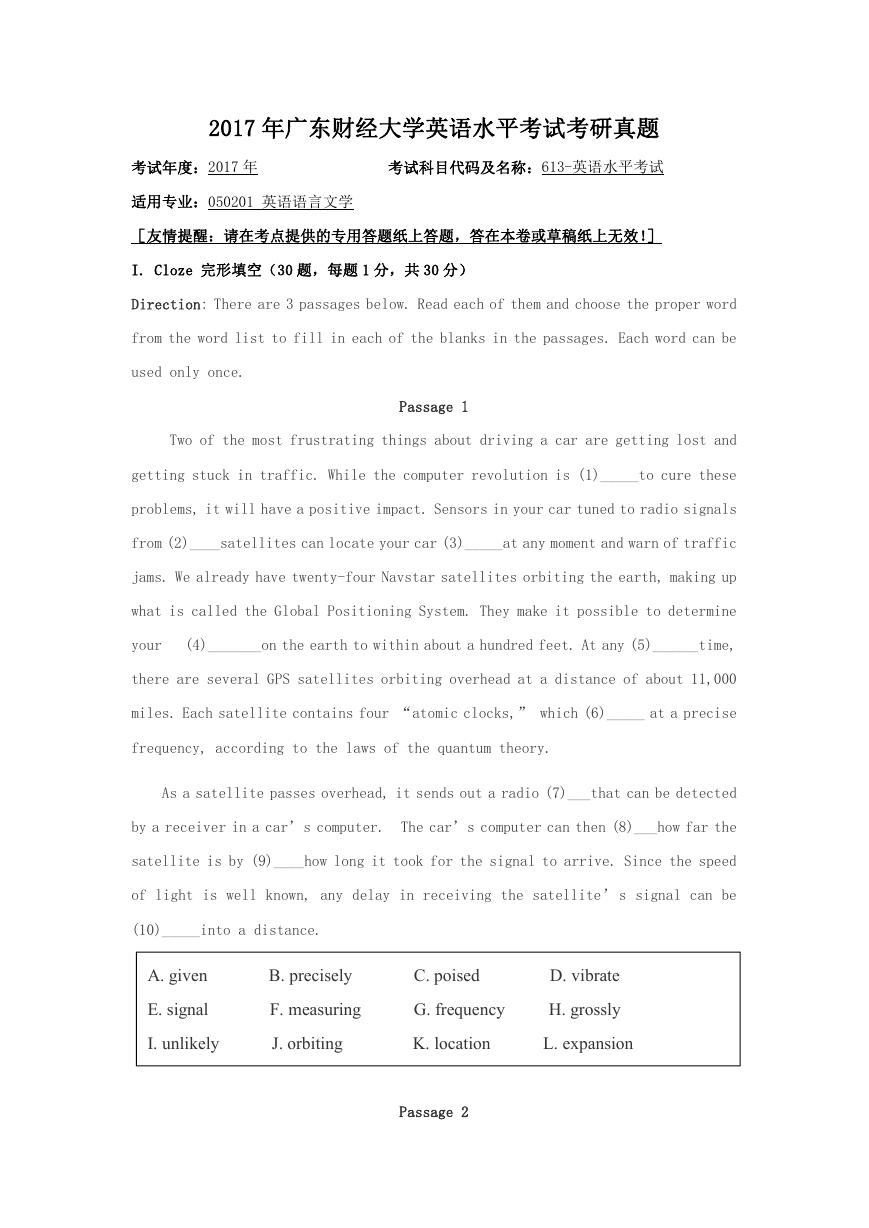

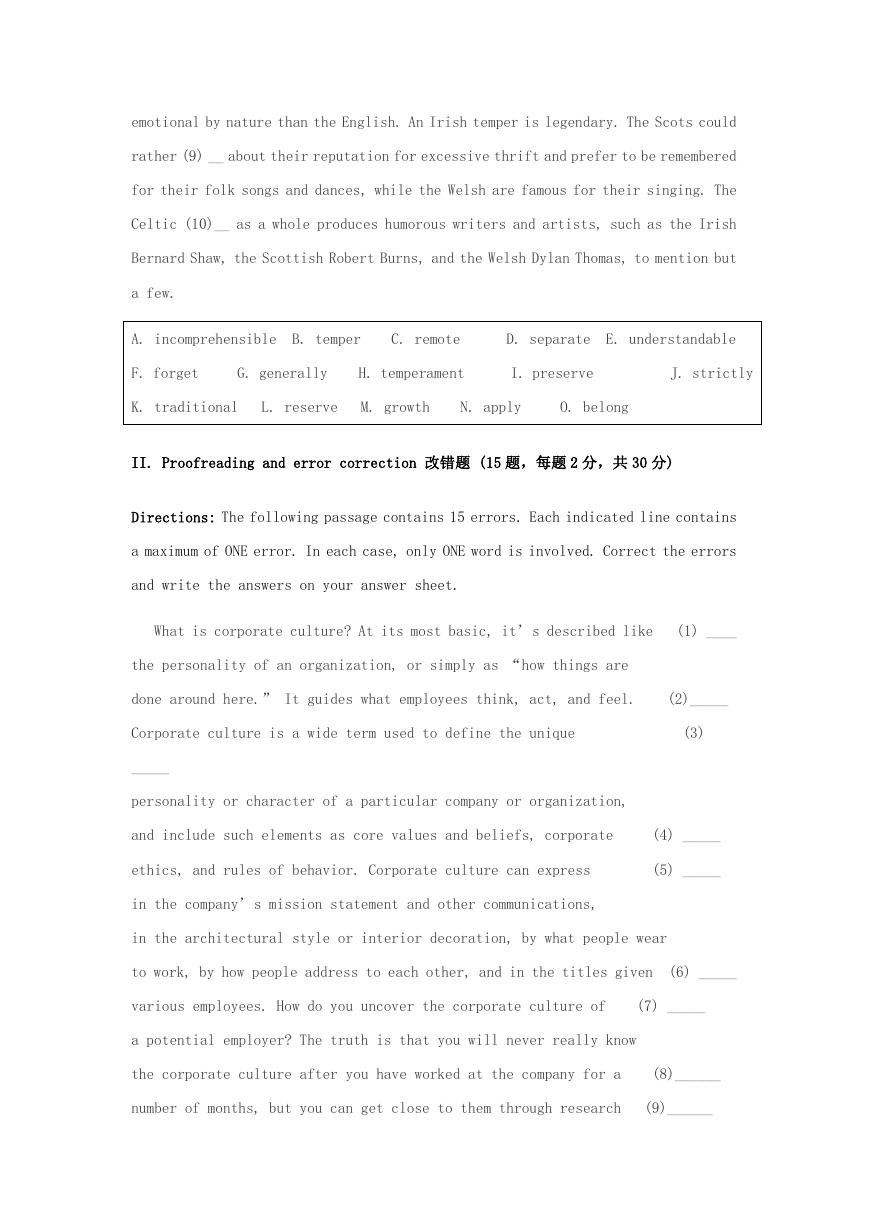
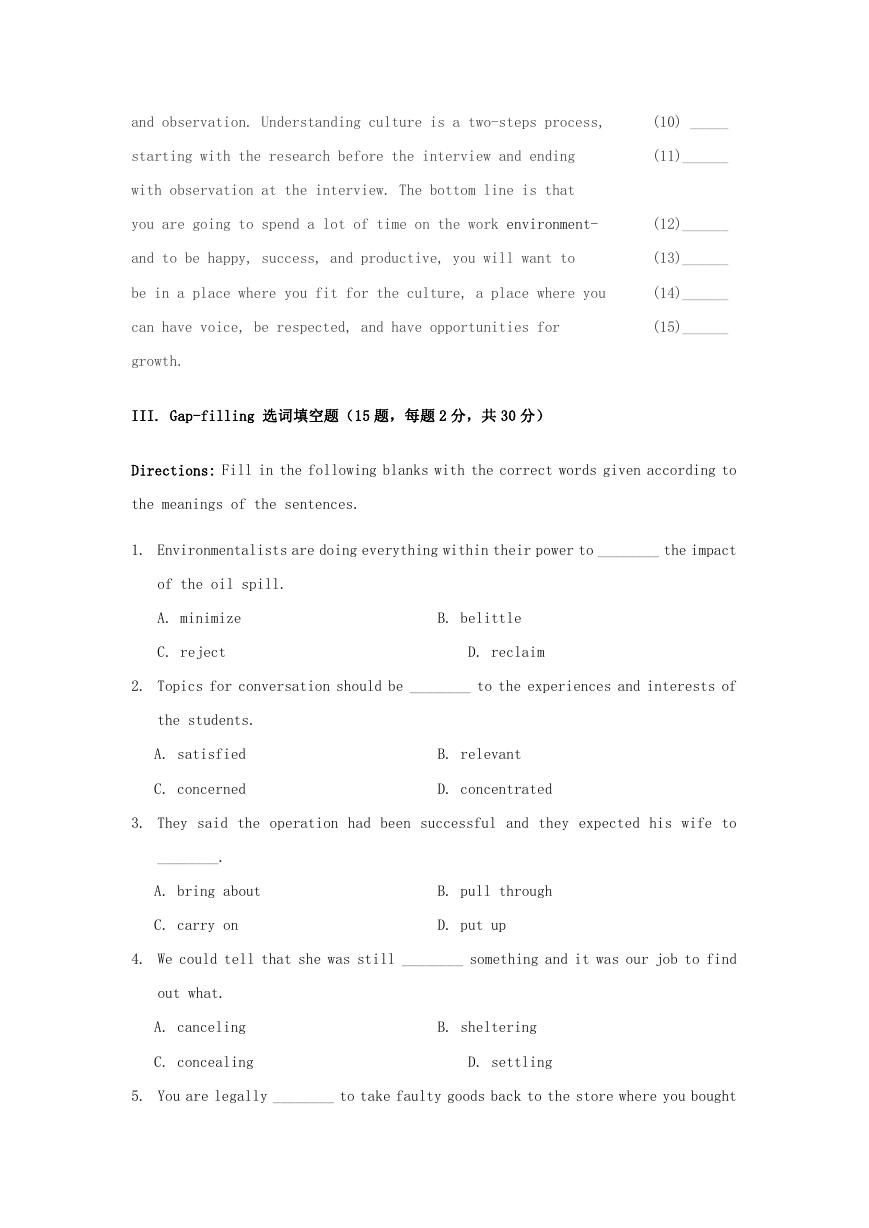
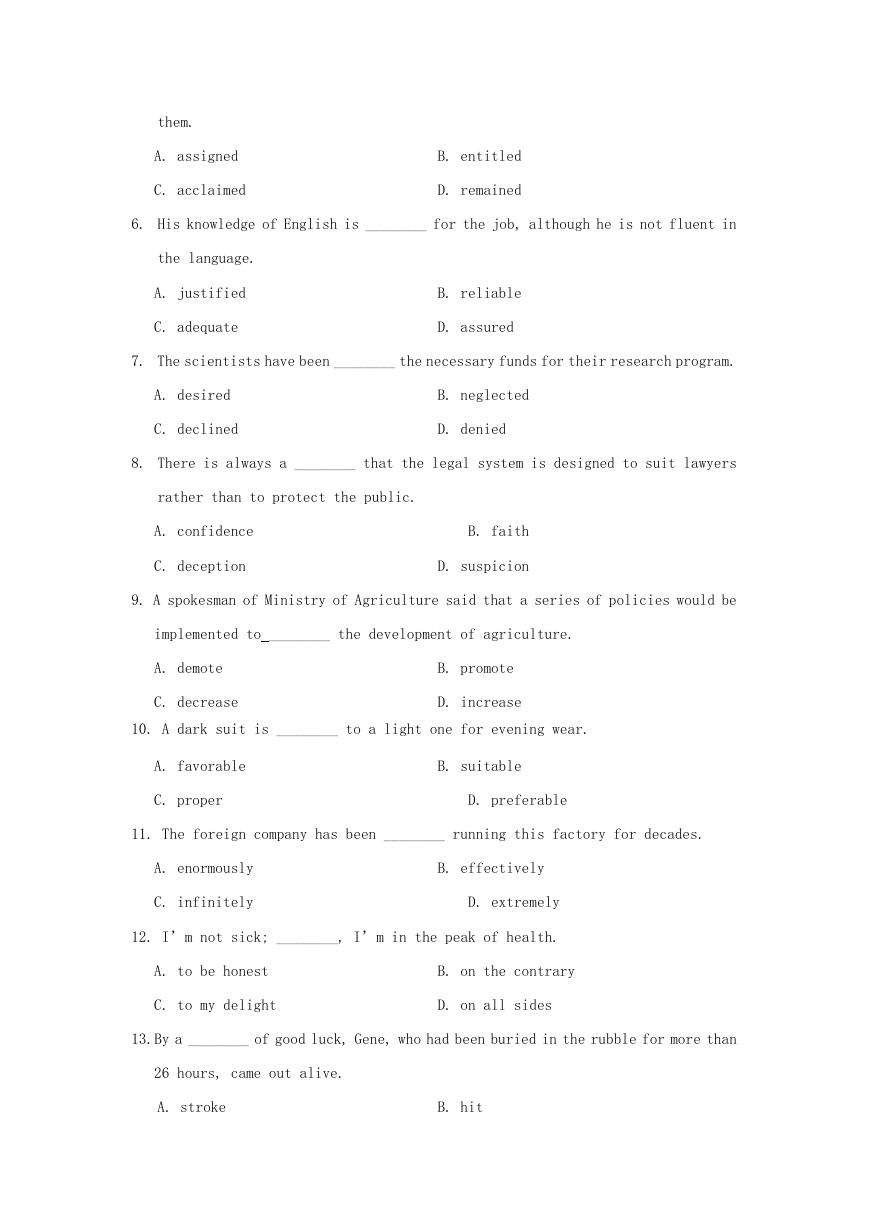
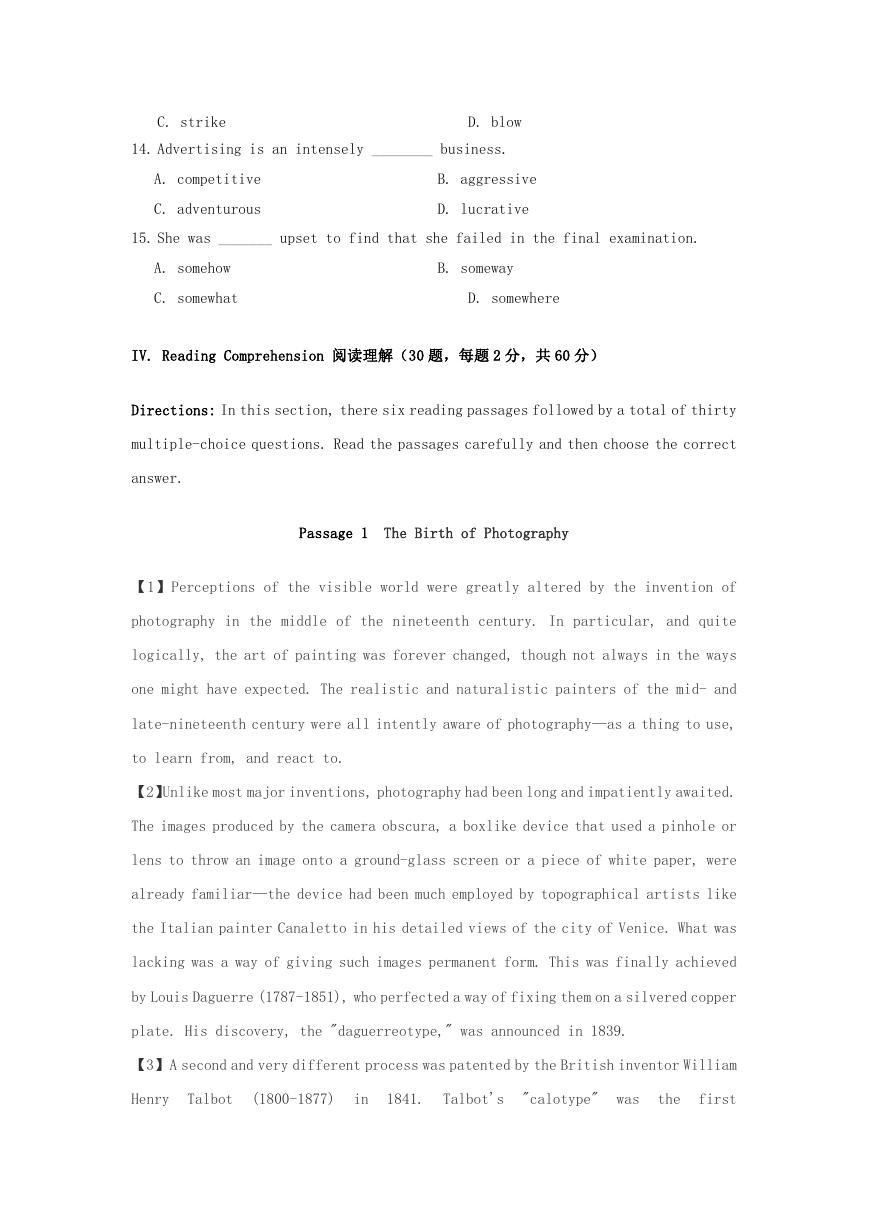
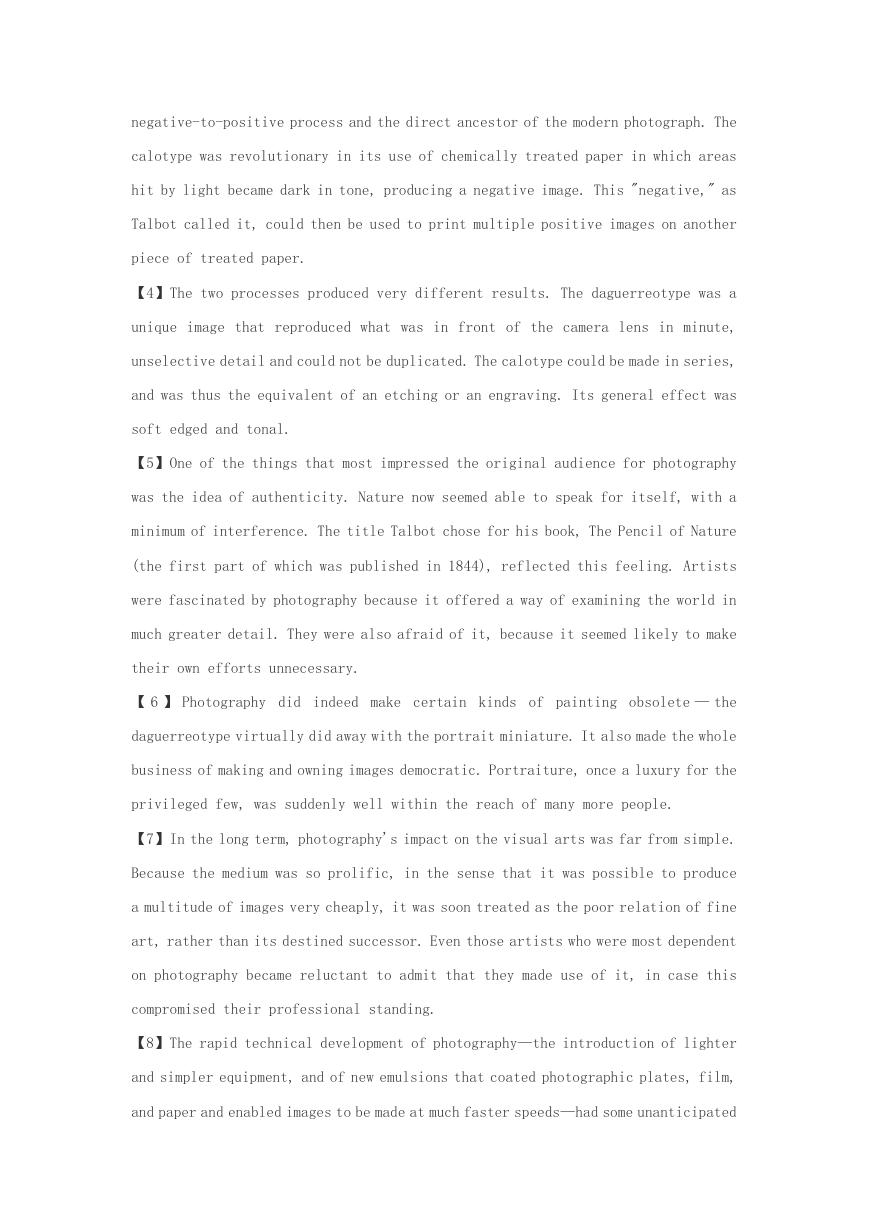
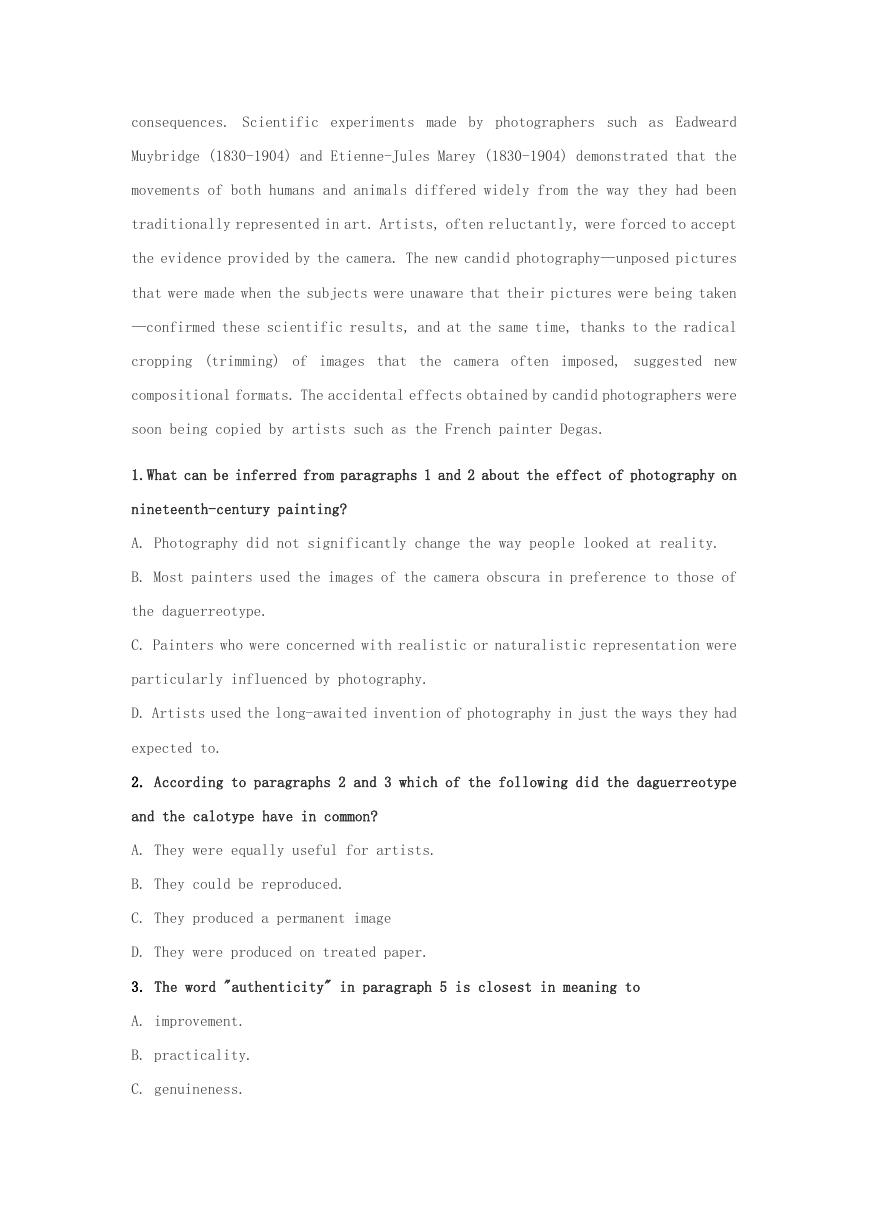








 2023年江西萍乡中考道德与法治真题及答案.doc
2023年江西萍乡中考道德与法治真题及答案.doc 2012年重庆南川中考生物真题及答案.doc
2012年重庆南川中考生物真题及答案.doc 2013年江西师范大学地理学综合及文艺理论基础考研真题.doc
2013年江西师范大学地理学综合及文艺理论基础考研真题.doc 2020年四川甘孜小升初语文真题及答案I卷.doc
2020年四川甘孜小升初语文真题及答案I卷.doc 2020年注册岩土工程师专业基础考试真题及答案.doc
2020年注册岩土工程师专业基础考试真题及答案.doc 2023-2024学年福建省厦门市九年级上学期数学月考试题及答案.doc
2023-2024学年福建省厦门市九年级上学期数学月考试题及答案.doc 2021-2022学年辽宁省沈阳市大东区九年级上学期语文期末试题及答案.doc
2021-2022学年辽宁省沈阳市大东区九年级上学期语文期末试题及答案.doc 2022-2023学年北京东城区初三第一学期物理期末试卷及答案.doc
2022-2023学年北京东城区初三第一学期物理期末试卷及答案.doc 2018上半年江西教师资格初中地理学科知识与教学能力真题及答案.doc
2018上半年江西教师资格初中地理学科知识与教学能力真题及答案.doc 2012年河北国家公务员申论考试真题及答案-省级.doc
2012年河北国家公务员申论考试真题及答案-省级.doc 2020-2021学年江苏省扬州市江都区邵樊片九年级上学期数学第一次质量检测试题及答案.doc
2020-2021学年江苏省扬州市江都区邵樊片九年级上学期数学第一次质量检测试题及答案.doc 2022下半年黑龙江教师资格证中学综合素质真题及答案.doc
2022下半年黑龙江教师资格证中学综合素质真题及答案.doc